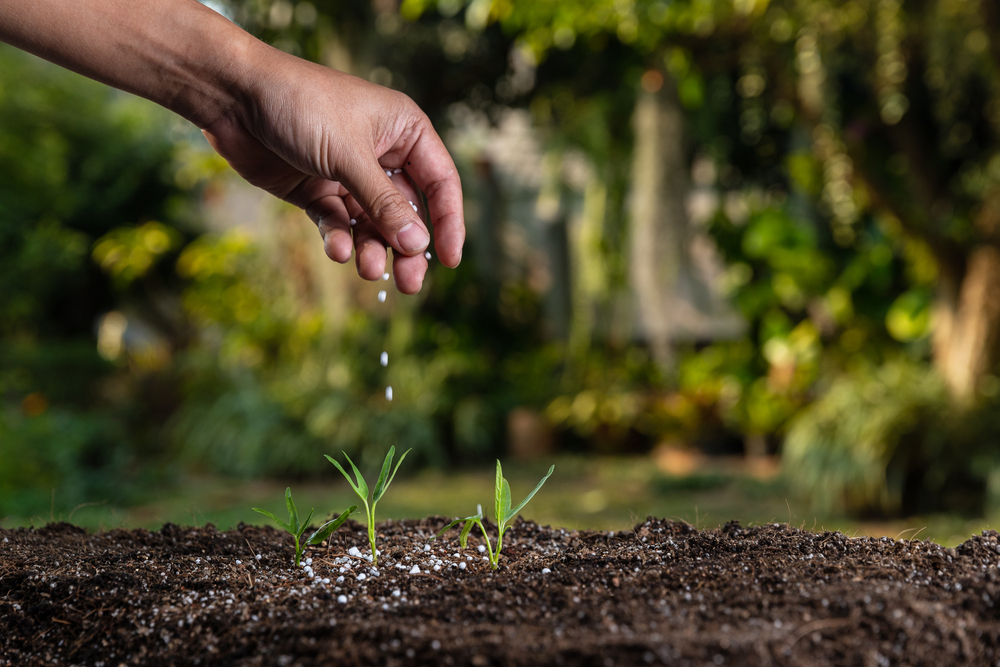
Image Source: Shutterstock.com
If you think lawn care season ends when the leaves start to fall, think again. Fall is actually one of the most important times to fertilize your lawn—but do it wrong, and you could end up doing more harm than good. The cooler weather makes it tempting to hang up the garden gloves, but your grass is still quietly growing beneath the surface, getting ready to hibernate through winter. Giving it the right nutrients now means lush, vibrant growth come spring.
So before you stash the mower and call it quits, here are seven fall fertilizing tips that will keep your lawn healthy, strong, and damage-free.
1. Time It Just Right
Timing is everything when it comes to fall fertilizing. Too early, and you’ll encourage new growth that can’t survive the first frost; too late, and your grass won’t absorb enough nutrients before it goes dormant. The sweet spot is typically early to mid-fall—when temperatures drop but the soil is still warm enough to stimulate root activity. Think of it as your lawn’s last big meal before winter. Proper timing helps strengthen roots without triggering that fragile, frost-prone growth.
2. Choose the Right Fertilizer Formula
Not all fertilizers are created equal, and fall calls for a specific blend. You want something rich in potassium and phosphorus—nutrients that promote root development and hardiness. Avoid high-nitrogen formulas that push top growth instead of deep strength. The goal is endurance, not a last-minute growth spurt. If you’re unsure, look for fertilizers labeled as “winterizing” blends; they’re designed to toughen up grass for the cold season ahead.
3. Don’t Skip the Soil Test
Before you even open that fertilizer bag, take a few minutes to test your soil. A soil test tells you what nutrients are missing and prevents you from overloading your lawn with unnecessary chemicals. Over-fertilizing isn’t just wasteful—it can burn the grass, throw off the pH balance, and cause long-term damage. Fall is a great time to correct nutrient imbalances so your lawn can recharge naturally. Plus, knowing your soil’s needs makes you sound like a lawn pro at the next neighborhood BBQ.
4. Mow and Aerate Before Fertilizing
You can’t just toss fertilizer on a neglected yard and expect magic. For the best results, mow your lawn slightly shorter than usual and give it a good aeration. Aeration allows air, water, and nutrients to reach the roots instead of just sitting on the surface. It also prevents soil compaction, which is one of the main reasons fertilizer doesn’t work effectively. Think of aerating like giving your lawn a deep-tissue massage—it’s the perfect prep before feeding time.
5. Watch the Weather Forecast
Your lawn might love nutrients, but rain can easily wash them away. Always check the forecast before fertilizing; you want mild, dry weather for at least 24 to 48 hours afterward. A light watering is good, but heavy rain will just send all your effort (and your money) flowing straight into the storm drain. Similarly, don’t fertilize when frost is expected within a day or two—it’ll lock those nutrients in place before the roots can absorb them. Waiting for the right weather window ensures maximum absorption and minimum waste.
6. Water Wisely After Application
After applying fertilizer, give your lawn a gentle watering to help dissolve the nutrients and carry them to the roots. Too much water, though, can create runoff or cause puddles that suffocate the grass. Aim for a light, steady soak that moistens the soil without flooding it. Fall watering habits differ from summer ones, so adjust your schedule accordingly—your lawn doesn’t need as much hydration in cooler weather. Consistent moisture, not constant saturation, is the key to success.

Image Source: Shutterstock.com
7. Avoid the Temptation to Overdo It
When it comes to fertilizer, more is definitely not better. Over-fertilizing can scorch your grass, promote disease, and even contaminate groundwater. It’s easy to think an extra scoop will make your lawn greener faster, but restraint is your best friend. Stick to the manufacturer’s instructions and focus on even coverage rather than heavy concentration. Your lawn will thank you with a strong, balanced recovery instead of a patchy, overfed mess.
Give Your Lawn the Fall Care It Deserves
A little attention now can make all the difference when spring rolls around. Fall fertilizing isn’t about making your lawn pretty—it’s about building strength, resilience, and protection against winter damage. With the right timing, the right blend, and a few smart habits, you’ll set your lawn up for success long before the first snowflake falls. So grab your spreader, plan your weekend project, and get ready to see the results of your effort bloom in the months ahead.
Have your own fall fertilizing tips or success stories? Share your thoughts and experiences in the comments below.
You May Also Like…
Why Over-Fertilizing Kills More Plants in Fall
5 Fertilizers to Skip in the Cool Season
6 Flower Beds That Benefit From Fall Re-Edging
12 Native Plants That Establish Best in Autumn
Why You Should Rethink Fall Fertilizer Applications
Leave a Reply